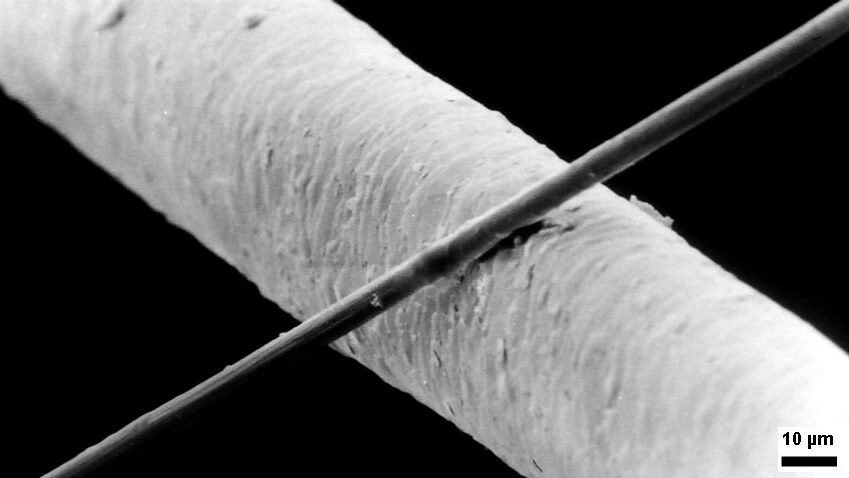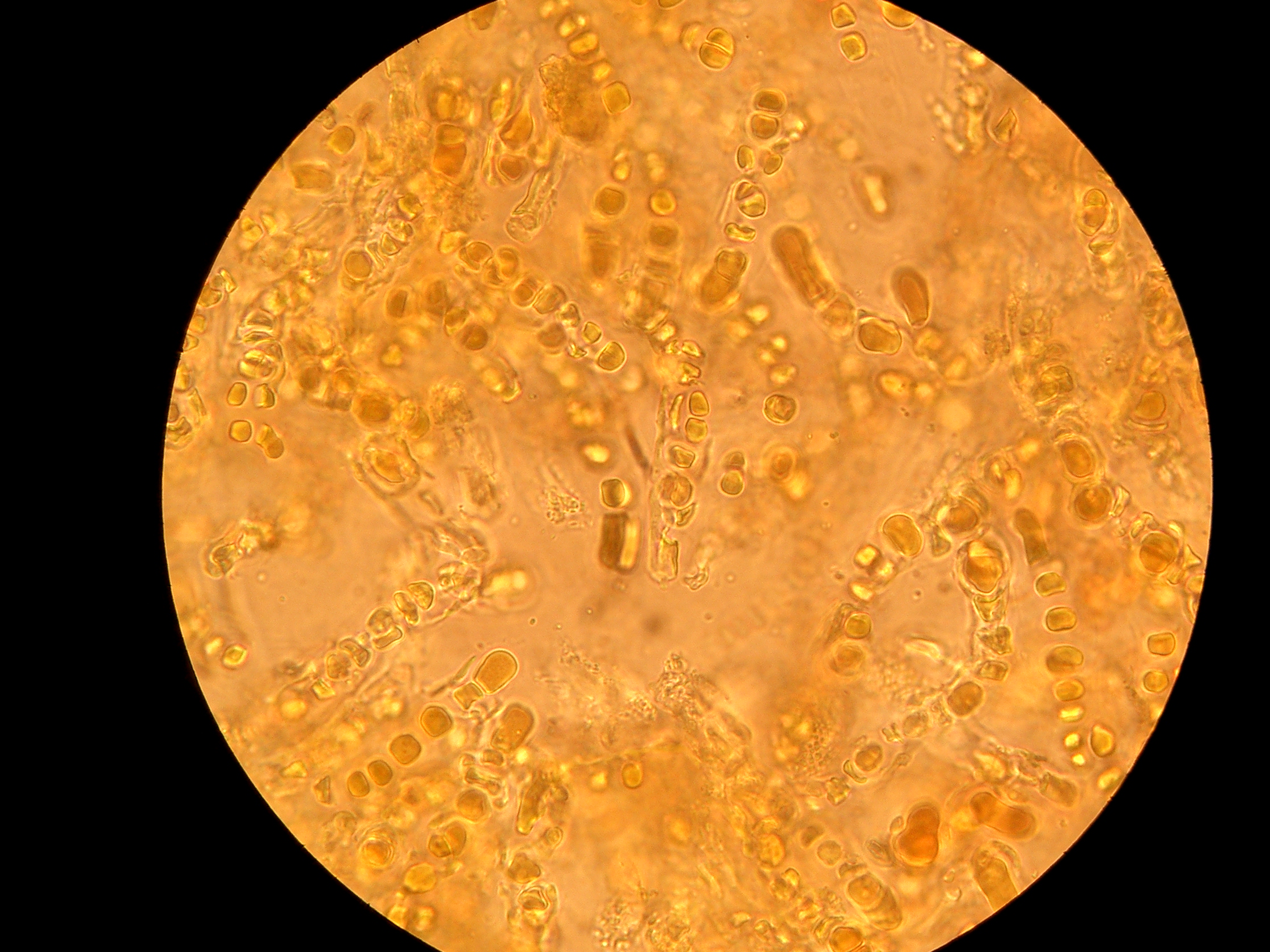|
Acanthothecis Submuriformis
''Acanthothecis submuriformis'' is a species of corticolous (bark-dwelling) lichen in the family Graphidaceae. Found in Brazil, it was formally described as a new species in 2022 by André Aptroot, Robert Lücking, and Marcela Eugenia da Silva M.Cáceres. The type specimen was collected from the Parque Natural Municipal (Porto Velho, Rondônia); here the lichen was found growing on tree bark in primary rainforest. It has a smooth, ochraceous white thallus lacking a cortex and lacking a prothallus. Its asci are 8-spored, and its ascospores are hyaline, measuring 29–31 by 6–8 μm. The specific epithet refers to the submuriform (somewhat chambered) spores; all spores have between 7 and 9 transverse septa, but of the 8 spores in the ascus, only about 2 have a longitudinal septum. ''Acanthothecis submuriformis'' contains lichexanthone, a lichen product that causes the thallus and ascomata margins to fluoresce yellow when lit with a long-wavelength UV light. This species an ... [...More Info...] [...Related Items...] OR: [Wikipedia] [Google] [Baidu] |
André Aptroot
André Aptroot ( Heemskerk, 1961) is a Dutch mycologist and lichenologist. In 1993 he did his PhD at the University of Utrecht under the supervision of Robbert Gradstein (nl). His dissertation was titled "Systematic studies on pyrenocarpous lichens and related fungi". He specializes in fungi and lichens on which he has several hundreds of publications to his name. He has worked as curator at Centraalbureau voor Schimmelcultures (now Westerdijk Institute). Aptroot is the founder of the Consultancy for Bryology and Lichenology, which is located in Soest where there is a herbarium with a collection of lichens mainly from the Netherlands and the tropics. From 2008 he has been collection manager at Pinetum Blijdenstein (nl) in Hilversum. He is a member of the International Association for Lichenology and the American Bryological and Lichenological Society. He is a visiting professor at the Federal University of Mato Grosso do Sul in Campo Grande, Brazil. Because of Aptro ... [...More Info...] [...Related Items...] OR: [Wikipedia] [Google] [Baidu] |
Micrometre
The micrometre ( international spelling as used by the International Bureau of Weights and Measures; SI symbol: μm) or micrometer ( American spelling), also commonly known as a micron, is a unit of length in the International System of Units (SI) equalling (SI standard prefix " micro-" = ); that is, one millionth of a metre (or one thousandth of a millimetre, , or about ). The nearest smaller common SI unit is the nanometre, equivalent to one thousandth of a micrometre, one millionth of a millimetre or one billionth of a metre (). The micrometre is a common unit of measurement for wavelengths of infrared radiation as well as sizes of biological cells and bacteria, and for grading wool by the diameter of the fibres. The width of a single human hair ranges from approximately 20 to . The longest human chromosome, chromosome 1, is approximately in length. Examples Between 1 μm and 10 μm: * 1–10 μm – length of a typical bacterium * 3–8 μm � ... [...More Info...] [...Related Items...] OR: [Wikipedia] [Google] [Baidu] |
Taxa Named By André Aptroot
In biology, a taxon (back-formation from ''taxonomy''; plural taxa) is a group of one or more populations of an organism or organisms seen by taxonomists to form a unit. Although neither is required, a taxon is usually known by a particular name and given a particular ranking, especially if and when it is accepted or becomes established. It is very common, however, for taxonomists to remain at odds over what belongs to a taxon and the criteria used for inclusion. If a taxon is given a formal scientific name, its use is then governed by one of the nomenclature codes specifying which scientific name is correct for a particular grouping. Initial attempts at classifying and ordering organisms (plants and animals) were set forth in Carl Linnaeus's system in ''Systema Naturae'', 10th edition (1758), as well as an unpublished work by Bernard and Antoine Laurent de Jussieu. The idea of a unit-based system of biological classification was first made widely available in 1805 in the int ... [...More Info...] [...Related Items...] OR: [Wikipedia] [Google] [Baidu] |
Lichens Of North Brazil
A lichen ( , ) is a composite organism that arises from algae or cyanobacteria living among filaments of multiple fungi species in a mutualistic relationship.Introduction to Lichens – An Alliance between Kingdoms . University of California Museum of Paleontology. Lichens have properties different from those of their component organisms. They come in many colors, sizes, and forms and are sometimes plant-like, but are not s. They may have tiny, leafless branches (); flat leaf-like structures ( |
Lichen Species
A lichen ( , ) is a composite organism that arises from algae or cyanobacteria living among filaments of multiple fungi species in a mutualistic relationship.Introduction to Lichens – An Alliance between Kingdoms . University of California Museum of Paleontology. Lichens have properties different from those of their component organisms. They come in many colors, sizes, and forms and are sometimes plant-like, but are not s. They may have tiny, leafless branches ( fruticose); flat leaf-like structures ( [...More Info...] [...Related Items...] OR: [Wikipedia] [Google] [Baidu] |
Acanthothecis
''Acanthothecis'' is a genus of lichen-forming fungi in the family Graphidaceae. The genus was circumscribed by Frederick Edward Clements in 1909. Species , Species Fungorum accepts 40 species of ''Acanthothecis''. *''Acanthothecis abaphoides'' *'' Acanthothecis adjuncta'' *'' Acanthothecis africana'' *''Acanthothecis alba'' – Mexico *'' Acanthothecis aquilonia'' – Australia *''Acanthothecis archeri'' – India *''Acanthothecis asprocarpa'' *''Acanthothecis aurantiaca'' *'' Acanthothecis aurantiacodiscus'' *'' Acanthothecis bicellularis'' – Brazil *''Acanthothecis bicellulata'' – Brazil *''Acanthothecis borealis'' – Australia *''Acanthothecis celata'' – India *''Acanthothecis coccinea'' – India *''Acanthothecis collateralis'' – India *''Acanthothecis dialeuca'' *''Acanthothecis dialeucoides'' – Thailand *''Acanthothecis farinosa'' – Brazil *''Acanthothecis floridana'' – United States *''Acanthothecis floridensis'' – United States *''A ... [...More Info...] [...Related Items...] OR: [Wikipedia] [Google] [Baidu] |
Acanthothecis Tetraphora
''Acanthothecis'' is a genus of lichen-forming fungi in the family Graphidaceae. The genus was circumscribed by Frederick Edward Clements in 1909. Species , Species Fungorum accepts 40 species of ''Acanthothecis''. *'' Acanthothecis abaphoides'' *'' Acanthothecis adjuncta'' *'' Acanthothecis africana'' *''Acanthothecis alba'' – Mexico *'' Acanthothecis aquilonia'' – Australia *'' Acanthothecis archeri'' – India *'' Acanthothecis asprocarpa'' *''Acanthothecis aurantiaca'' *'' Acanthothecis aurantiacodiscus'' *'' Acanthothecis bicellularis'' – Brazil *'' Acanthothecis bicellulata'' – Brazil *''Acanthothecis borealis'' – Australia *''Acanthothecis celata'' – India *''Acanthothecis coccinea'' – India *''Acanthothecis collateralis'' – India *''Acanthothecis dialeuca'' *''Acanthothecis dialeucoides'' – Thailand *''Acanthothecis farinosa'' – Brazil *''Acanthothecis floridana'' – United States *''Acanthothecis floridensis'' – United States ... [...More Info...] [...Related Items...] OR: [Wikipedia] [Google] [Baidu] |
UV Light
Ultraviolet (UV) is a form of electromagnetic radiation with wavelength from 10 nm (with a corresponding frequency around 30 PHz) to 400 nm (750 THz), shorter than that of visible light, but longer than X-rays. UV radiation is present in sunlight, and constitutes about 10% of the total electromagnetic radiation output from the Sun. It is also produced by electric arcs and specialized lights, such as mercury-vapor lamps, tanning lamps, and black lights. Although long-wavelength ultraviolet is not considered an ionizing radiation because its photons lack the energy to ionize atoms, it can cause chemical reactions and causes many substances to glow or fluoresce. Consequently, the chemical and biological effects of UV are greater than simple heating effects, and many practical applications of UV radiation derive from its interactions with organic molecules. Short-wave ultraviolet light damages DNA and sterilizes surfaces with which it comes into contact. For ... [...More Info...] [...Related Items...] OR: [Wikipedia] [Google] [Baidu] |
Fluoresce
Fluorescence is the emission of light by a substance that has absorbed light or other electromagnetic radiation. It is a form of luminescence. In most cases, the emitted light has a longer wavelength, and therefore a lower photon energy, than the absorbed radiation. A perceptible example of fluorescence occurs when the absorbed radiation is in the ultraviolet region of the electromagnetic spectrum (invisible to the human eye), while the emitted light is in the visible region; this gives the fluorescent substance a distinct color that can only be seen when the substance has been exposed to UV light. Fluorescent materials cease to glow nearly immediately when the radiation source stops, unlike phosphorescent materials, which continue to emit light for some time after. Fluorescence has many practical applications, including mineralogy, gemology, medicine, chemical sensors (fluorescence spectroscopy), fluorescent labelling, dyes, biological detectors, cosmic-ray detection, vacuu ... [...More Info...] [...Related Items...] OR: [Wikipedia] [Google] [Baidu] |
Ascomata
An ascocarp, or ascoma (), is the fruiting body ( sporocarp) of an ascomycete phylum fungus. It consists of very tightly interwoven hyphae and millions of embedded asci, each of which typically contains four to eight ascospores. Ascocarps are most commonly bowl-shaped (apothecia) but may take on a spherical or flask-like form that has a pore opening to release spores (perithecia) or no opening (cleistothecia). Classification The ascocarp is classified according to its placement (in ways not fundamental to the basic taxonomy). It is called ''epigeous'' if it grows above ground, as with the morels, while underground ascocarps, such as truffles, are termed ''hypogeous''. The structure enclosing the hymenium is divided into the types described below (apothecium, cleistothecium, etc.) and this character ''is'' important for the taxonomic classification of the fungus. Apothecia can be relatively large and fleshy, whereas the others are microscopic—about the size of flecks ... [...More Info...] [...Related Items...] OR: [Wikipedia] [Google] [Baidu] |
Lichen Product
Lichen products, also known as lichen substances, are organic compounds produced by a lichen. Specifically, they are secondary metabolites. Lichen products are represented in several different chemical classes, including terpenoids, orcinol derivatives, chromones, xanthones, depsides, and depsidones. Over 800 lichen products of known chemical structure have been reported in the scientific literature, and most of these compound are exclusively found in lichens. Examples of lichen products include usnic acid (a dibenzofuran), atranorin (a depside), lichexanthone (a xanthone), salazinic acid (a depsidone), and isolichenan, an α-glucan. Many lichen products have biological activity, and research into these effects is ongoing. Lichen products accumulate on the outer walls of the fungal hyphae, and are quite stable. Crystal deposits can be visualised using scanning electron microscopy. For this reason, even very old herbarium specimens can be analysed. The amount of lichen ... [...More Info...] [...Related Items...] OR: [Wikipedia] [Google] [Baidu] |





